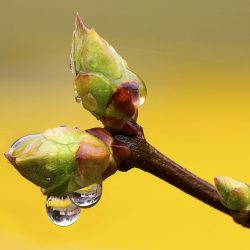Gemmotherapy, an emerging branch of phytotherapy, is attracting growing interest in the field of natural medicine. This therapeutic approach uses the embryonic tissues of plants – mainly buds, young shoots and rootlets – to produce extracts with medicinal properties. Unlike traditional phytotherapy, which exploits the mature parts of plants (leaves, flowers, roots), gemmotherapy takes advantage of the biological potential concentrated in growing tissues. These young tissues contain a wealth of bioactive elements such as vitamins, minerals, amino acids and phytohormones. Recent studies have highlighted the potential effects of gemmotherapy in supporting the immune system, detoxification and regulating inflammatory processes.
How did gemmotherapy come about?
Gemmotherapy was born in the 1950s thanks to the work of the Belgian doctor Pol Henry, who is considered to be its founder. By taking an interest in buds and other embryonic plant tissues, he discovered that these growing tissues contained specific active ingredients. Unlike mature plants, these young tissues had greater therapeutic potential due to their concentration of bioactive elements such as phytohormones. Pol Henry then developed the concept of phytoembryotherapy, a method aimed at exploiting the biological properties of plant embryonic cells.
Through his clinical research, he demonstrated that these embryonic tissues had a measurable impact on mammalian health, based on biochemical analyses. He was particularly interested in the changes in serum proteins in animals after administration of bud macerates. This discovery marked the beginning of gemmotherapy as a natural treatment method that complements phytotherapy.
Later, the term “gemmotherapy” was adopted by Dr Max Tétau, who continued Henry’s research and introduced a more clinical aspect to the method. He developed its therapeutic applications, emphasising the importance of buds in regulating and stimulating human physiological functions. Today, gemmotherapy is recognised as an effective method for treating a variety of ailments, thanks to its glycerol macerates derived from buds.
What are the principles of this branch of phytotherapy?
Gemmotherapy is based on the use of the embryonic tissues of plants, such as buds, young shoots, catkins, inner bark and roots, which are rich in meristems. These tissues play a key role in the continued growth of plants, thanks to their ability to produce totipotent cells, comparable to stem cells in animals. Unlike adult cells, meristems allow regeneration and growth throughout the life of the plant.
Buds are particularly used in gemmotherapy because they contain a high concentration of phytohormones, such as auxins, gibberellins and cytokinins, which regulate cell growth and differentiation. These hormones, combined with vitamins, flavonoids and trace elements, give buds unique therapeutic properties, tailored to the body’s specific needs.
In gemmotherapy, bud extracts are obtained by maceration in a mixture of glycerine,alcohol and water, which preserves their active ingredients. This method provides a highly concentrated plant-based therapy, allowing better absorption of the bioactive elements. Thanks to their regenerative potential and wealth of bioactive compounds, buds offer natural solutions for supporting detoxification, stimulating the immune system and promoting the balance of various biological processes.
How to use these bud extracts?
To use gemmotherapy extracts effectively, it is essential to follow the recommendations adapted to each patient and the pathology to be treated. Gemmotherapy practitioners distinguish between three main approaches: clinical prescription, drainage and biological prescription.
Clinical prescription is based on a precise diagnosis. Each gemmoderivative targets specific systems or organs. For example, to treat allergies, practitioners often prescribe Blackcurrant buds (Ribes nigrum) because of their anti-inflammatory and cortisone-like properties . For anxiety and digestive problems, Linden buds (Tilia tomentosa) have sedative and antispasmodic effects.
Drainage aims to detoxify the body by stimulating the emunctory organs (liver, kidneys, skin, lungs). This approach improves the elimination of toxins and prepares the body for a more targeted treatment.
Finally, biological prescription, introduced by Dr Pol Henry, is based on in-depth biological analyses to adapt treatments to the phytosociology of the plant.
Glycerol macerates are generally administered orally, in the form of drops diluted in water. For a concentrated macerate, 5 to 15 drops per day are recommended, while a 1D glycerol macerate requires 50 to 150 drops. Dosage can be adapted according to the patient’s age and condition, with particular attention paid to children and pregnant women.
Are there any precautions for use?
Gemmotherapy is a relatively safe treatment, with few contraindications and side effects. However, certain precautions must be taken when using it. Firstly, it is essential not to use a gemmoderivative if the patient has already had an allergic reaction to the plant concerned.
Pregnant women should avoid extracts with hormonal properties, such as Raspberry, Oak or Red Bilberry buds, as well as those containing potentially toxic compounds, such as Boxwood. Certain extracts, such as Juniper or Thuja, should also be avoided as they may cause uterine contractions.
Nursing mothers should avoid buds such as Alder, which can reduce milk production. In addition, patients suffering from or with a history of hormone-dependent cancers should avoid extracts with a hormonal action, such as Blackcurrant or Rosemary.
Interactions with anticoagulants may occur, particularly with plants such as Ginkgo, which thins the blood. In addition, certain extracts, such as Blackcurrant, should be taken in the morning to respect the circadian rhythm of natural corticoids.
Finally, people undergoing alcohol withdrawal should avoid gemmotherapy extracts containing alcohol. It is important to remember that, despite its many potential benefits, gemmotherapy has not yet been the subject of recognised clinical studies, which limits its status as an officially validated treatment.
What are the limitations of this therapeutic practice?
The clinical applications of gemmotherapy are mainly based on the use of glycerol macerates, which are classified as food supplements. These concentrated extracts from buds and young shoots have a physiological effect, but their therapeutic effects have yet to be scientifically demonstrated.
Preliminary studies suggest that certain buds, such as those of Blackcurrant (Ribes nigrum), have anti-inflammatory and immunostimulant effects, comparable to natural steroids, without the side effects of corticoids. Other research shows that Linden buds (Tilia tomentosa) may have sedative properties, while young shoots of Rosemary (Rosmarinus officinalis) have a beneficial effect on liver function.
However, despite these promising results, the scientific evidence remains limited. Most of the studies available are of poor methodological quality, with little reliable clinical data. Many experiments lack scientific rigour, such as the absence of detailed protocols or solid statistical results, making it impossible to fully validate the therapeutic efficacy of gemmotherapy extracts.
Despite these limitations, the use of gemmotherapy in the management of inflammatory diseases, stress and immune disorders continues to attract interest. For these extracts to be fully integrated into medical practice, more in-depth and rigorous clinical studies are essential to prove their efficacy and safety.





